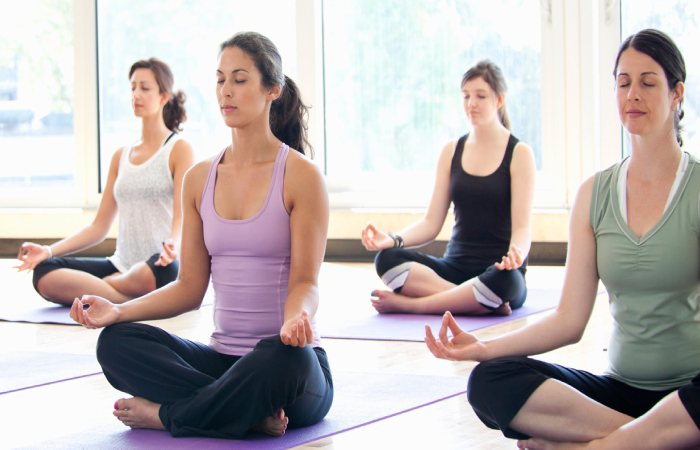Table of Contents
How I Experienced the Benefits Of Yoga
I experienced the genuine healing power of yoga. Weeks before traveling to India in 2002 to study fitness yoga therapy, I developed numbness and tingling in my right hand. After considering scary things like a brain tumor and multiple sclerosis, I discovered that the cause of the symptoms was thoracic outlet syndrome, a nerve block in the neck and chest.

How Yoga Improves Your Health
My experience inspired me to reflect on the scientific studies I had accumulated in India and the West to discover and explain how yoga can prevent illness and aid recovery fitness. It is what I found.
Improve Your Versatility
Improved flexibility is one of the greatest and most obvious benefits of yoga. During your first lesson, you may not be able to touch your toes, much less bend your back. But if you hold it, you will notice a gradual relaxation, and seemingly impossible poses will eventually become possible.
Build Muscle Strength
Strong muscles don’t just look good. They also protect us from arthritis and back pain and help prevent falls in the elderly. And as strength builds through yoga, it balances it with flexibility. If you only moved to the gym and raised weight, you can build muscle at the expense of flexibility.
Perfect Your Position
Your head is like a skittles ball: big, round, and heavy. When balanced directly on an upright spine, it is much less work for your neck and back muscles to support you. However, move it forward a few inches, and it will begin to tense those muscles. Hold that bowling ball leaning forward for eight to twelve hours a day, and it’s no wonder you’re tired.
“To further improve your posture, you can perform exercises that strengthen the muscles in your neck and back. Check out this article on neck fat exercises from Iron Neck for some great tips and exercises to get started.”
Prevents Cartilage and Joint Degradation
Every time you practice yoga, you take your joints through their full range of motion. It can help prevent degenerative arthritis or ease disability by “squeezing and soaking” areas of cartilage. Regular Yoga Classes allow you to keep your joints and bones healthy and strong. Look for a studio that offers yoga classes for all skill levels, specialized courses, and private therapy sessions.
Protect Your Spine
Intervertebral discs, the shock absorbers between vertebrae that can break and compress nerves, require movement. It is the only way to get your nutrients. When you have a balanced asana practice with lots of backbends, forward bends, and twists, you will keep your spinal discs flexible.
Improve Your Posture
Yoga isn’t just for improving flexibility; it’s also for improving posture. It’s essential to understand the difference between posture and flexibility. Flexibility is how far you can stretch your body to do specific movements. Posture is the alignment of the body when it’s at rest or during an activity. Having good posture can help you avoid pain and injury. Yoga improves both flexibility and posture because you’re constantly working to extend your body and align it. It’s essential to stretch your body to its full potential, but it’s equally important to focus on your posture.
Improve Your Bone Health
It is well documenting that weight training strengthens bones and helps fight osteoporosis. Several of the yoga postures need you to lift your weight. And some, like Adho Mukha Svanasana (Downward-Facing Dog) and Urdhva Mukha Svanasana (Upward-Facing Dog), help strengthen the bones in the arm, which are particularly prone to osteoporotic fractures.
Increase Your Blood Circulation
Yoga makes your blood flow. More particularly, the relaxation activities you learn in yoga can improve your circulation, especially nutrition in your hands and feet. Yoga also delivers more oxygen to the cells, which makes them work better.
Promote Better Sleep
Yoga is a traditional practice that involves a series of poses and movements that increase flexibility and strength. Yoga is a stress reliever and a way to relax the body and mind. It has a positive impact on the physical and mental health of those who practice regularly, including reducing insomnia and a better ability to sleep longer.
Increase Your Heart Rate
Keeping your heart rate in the aerobic range typically will lower your risk of heart attack and can help ease depression. While not all yoga is aerobic, if you do it vigorously or take a fluency or Ashtanga class, you can get your heart rate up to the aerobic range.
Takeaway
Yoga is an excellent activity to improve your physical health, but it also benefits your lifestyle by promoting good practices and habits. Yoga goes beyond physical exercise. It can help you positively enhance your mental and emotional state of being. It’s a form of exercise that requires a good amount of focus and determination. Yoga is also a practice of self-awareness and self-discovery. Whether at home or in a nearby studio, practicing daily yoga can improve your life from the inside out.

